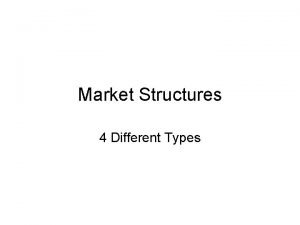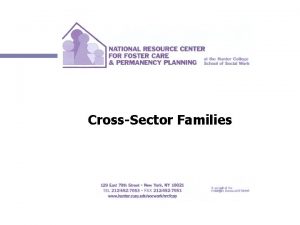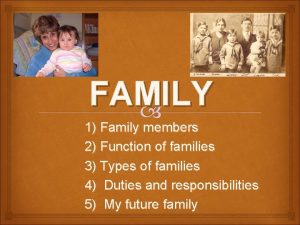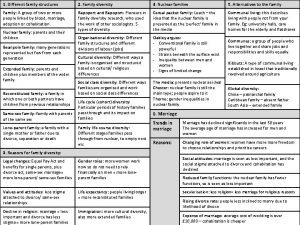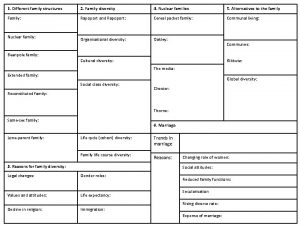HOW FAMILIES FUNCTION IN DIFFERENT FAMILY STRUCTURES FAMILY










- Slides: 10

HOW FAMILIES FUNCTION IN DIFFERENT FAMILY STRUCTURES FAMILY SOCIAL INSTITUTION BY: ANAISA MAYFIELD

HISTORY The idea on how family came about was through marriage. Marriage is when two partners vow to spend the rest of their lives with each other, creating what we call a family. There are many definitions on what a family is. A family is a group of people who come together to form a primary connection, gaining emotional ties over a period of time. What would actually define family is a relationship conducted by blood, marriage, or adoption. Society bases their beliefs on what a family is by the traditional family model, consisting of two parents(mother and father) and children. It is what society believes the best way to raise children. In a functionalists perspective, family is one of the most important social institutions life withholds, stabilizing society. It gives a person guidance and a view on their culture. Family can affect a person’s lively outcomes. It can influence how one lives their life based on how they were raised and what they’re being taught. That it distinguishes gender roles and provides life lessons. Conflict theorists believe that whoever is making the most money in one household has power. Conflict theorists initiate that American families do not want the government telling them how to raise their children. Instead, Parents decide how they’re going to raise their children and give them sets of rules to follow.

NUCLEAR FAMILY STRUCTURE A nuclear family is what a traditional type of family is viewed as. This type of family consists of two parents and children. Parents in this type of structure often stress less about financial stability due to the help of their significant other. Children in this type of structure often gain power and stability due to the support of both parents, enabling them to have more opportunities. This type of family often lives a successful life. They often graduate from good schools, get their degrees, and find a well paying job.

SINGLE PARENT FAMILY STRUCTURE A single-parent family. This type of family usually consists of one parent raising one or more children. In most cases, a single parent household usually concludes a mother and her children although there are single parent fathers. It is often a chore to be a single parent due to the fact that the parent has to work to support their children. When this is the case, it is hard for the parent to find care for her child. Most of the time, the other parent will offer to watch the children to help as well as spend time with their children. 36 percent of children who are born to a single mother become a part of a two-parent household within five years.

CHILDLESS FAMILY STRUCTURE A childless family occurs when a married unit does not have children. This type of structure strictly consists of a husband wife only. This structure usually exists when the couple can’t produce or does not want children. Most of the time, society doesn’t view this type of structure as an actual family due to their idea that children are what conclude a family. Statistically proven, childless families usually take on the responsibility of becoming pet owners or tend to create a strong bond with their nieces and nephews as a substitution of having their own children.

STEPPARENT FAMILY STRUCTURE A stepfamily exists when two parents, who were once married, separate or divorce and eventually remarry. What makes up a stepfamily is children from previous relationships, a biological parent, and their new spouse in which whom they’ve married. Stepfamilies are the second most common type of family structure in society today. Although this structure is as common as a traditional/nuclear family, this structure tends to experience more problems. One of the main issues this structure inhabits is learning how to work together within the family and cohabitating with their past relationships. Children who are adapted into this structure often have disciplinary issues.

GENDER ROLES Gender roles play a huge part in families today. It is what specifies how the family functions. Each member of the family divides labor that consists of instrument and expressive roles. Instrument roles involve manual labor outside of the home which provides financial support towards the family. Examples of instrument roles include construction, business running, federal/ law firms etc. Men are usually a part of the instrumental roles, given take that they are more predominant. Expressive roles involve labor inside of the home which provides physical and emotional support for the children in the household. Examples of expressive roles include cooking for the family, cleaning the house, washing clothes and dishes etc. Women are often a part of expressive roles because they tend to be more nurturing.

Family Structure 4 3. 5 3 2. 5 2 1. 5 1 0. 5 2000 0 Nuclear Single Parent Childless 1970 2000 Stepparent 1970

In conclusion, family is a very important part of life. Its what builds a person from childhood to adulthood, preparing someone for the real world. Although family has different meanings and structures, it still serves its purpose in society. How I would improve this institution is by making sure I am doing right by my family and society. I will make sure that I am doing right by my future family by teaching them the right things, providing for them, and prepare them for the real world.

WORK CITED ADMC “Bar Chart: Changes in Types of Household” ADMC Common Year English Writing. Web. 2006. Blessing, Michelle. “Types of Family Structures” Love To Know. Lovetoknow. com Bumpass, Larry L. , and Sweet James A. "Children's Experience in Single-Parent Families: Implications of Cohabitation and Marital Transitions. " Family Planning Perspectives 21. 6 (1989): 256 -60. Web. Coltrane, Scott. "Research on Household Labor: Modeling and Measuring the Social Embeddedness of Routine Family Work. " Journal of Marriage and Family 62. 4 (2000): 1208 -233. Web. Lofquist, Amy “The effects of Remarriage on Children” Nathional Stepfamily Resource Center. SAA Stepfamilies. 1993 "Nuclear Families. " International Encyclopedia of Marriage and Family. 2003. Encyclopedia. com. 25 Jul. 2016 <http: //www. encyclopedia. com>. Williams, Brian K. Sawyer, Stacey C and. Wahlstrom, Carl M. "Marriages, Families & Intimate Relationships" US Census Bureau. Published by Pearson, 2006.
 Big families vs small families
Big families vs small families Homologous structures definition
Homologous structures definition Pure competition market
Pure competition market Planar molecular shape
Planar molecular shape Why do different polymers have different properties
Why do different polymers have different properties Technicolor test
Technicolor test Sound will travel at different speeds in different mediums.
Sound will travel at different speeds in different mediums. Lrefraction
Lrefraction What is cultural relativism
What is cultural relativism Different angle different story
Different angle different story Acid and base song
Acid and base song


